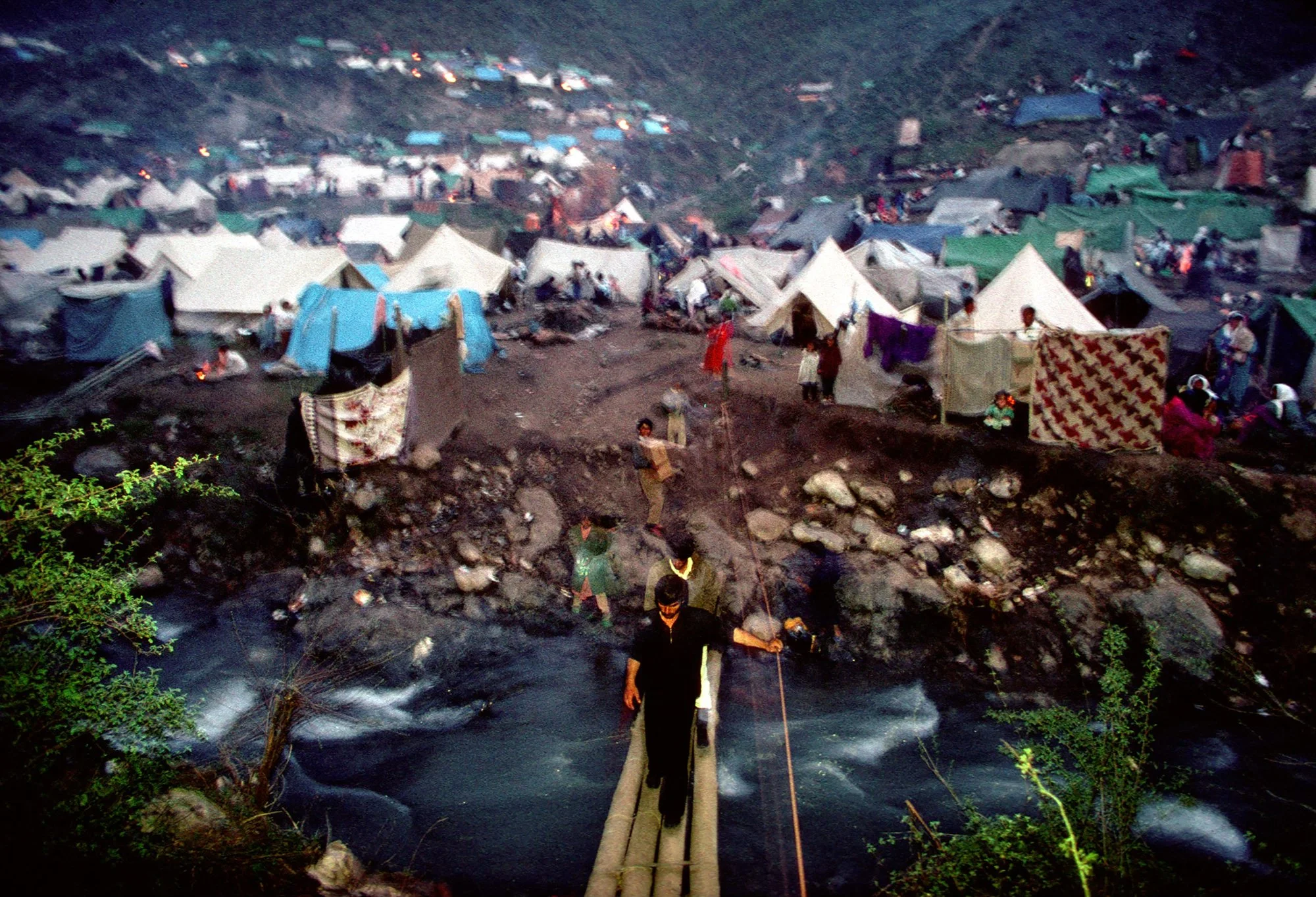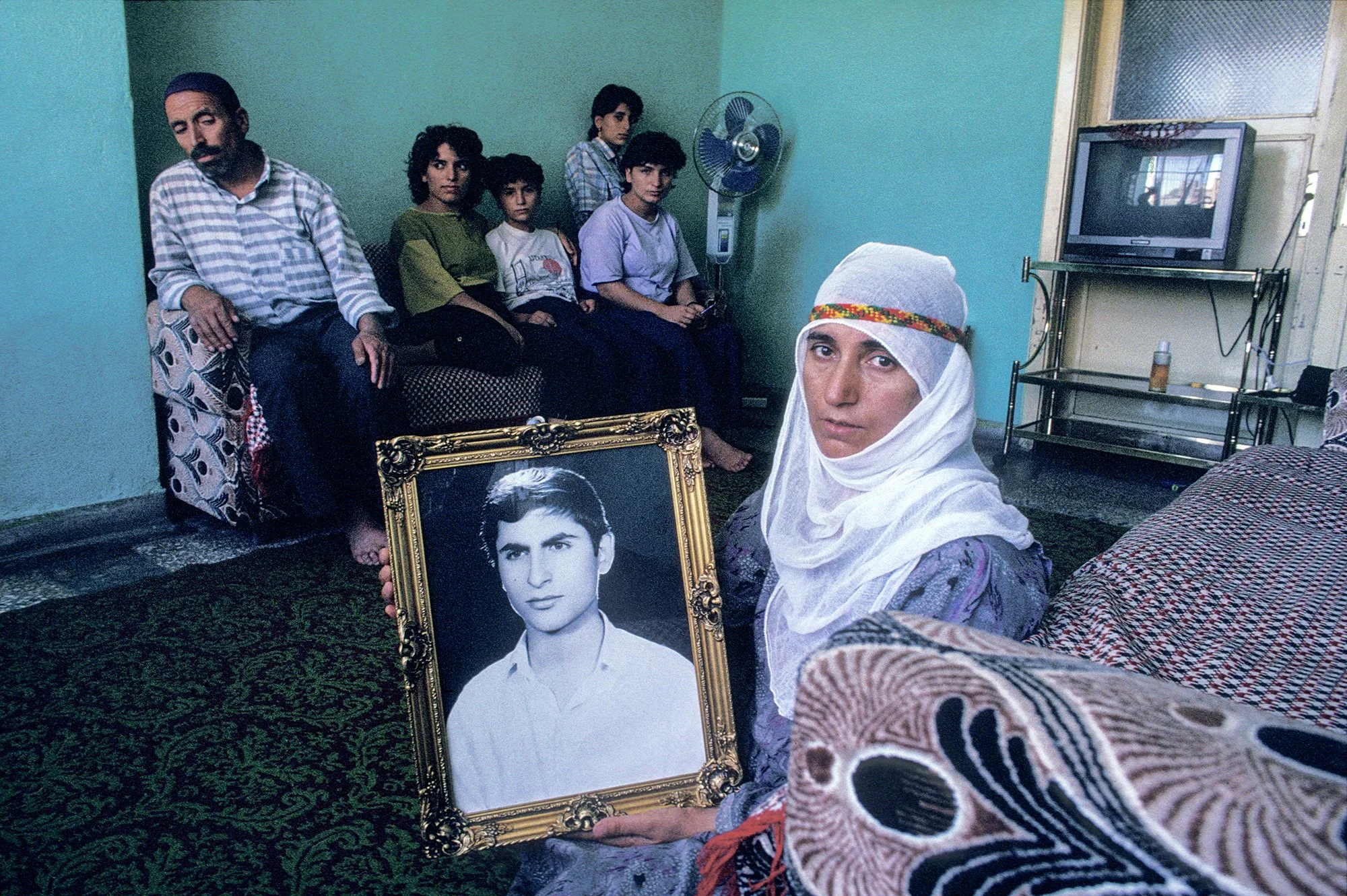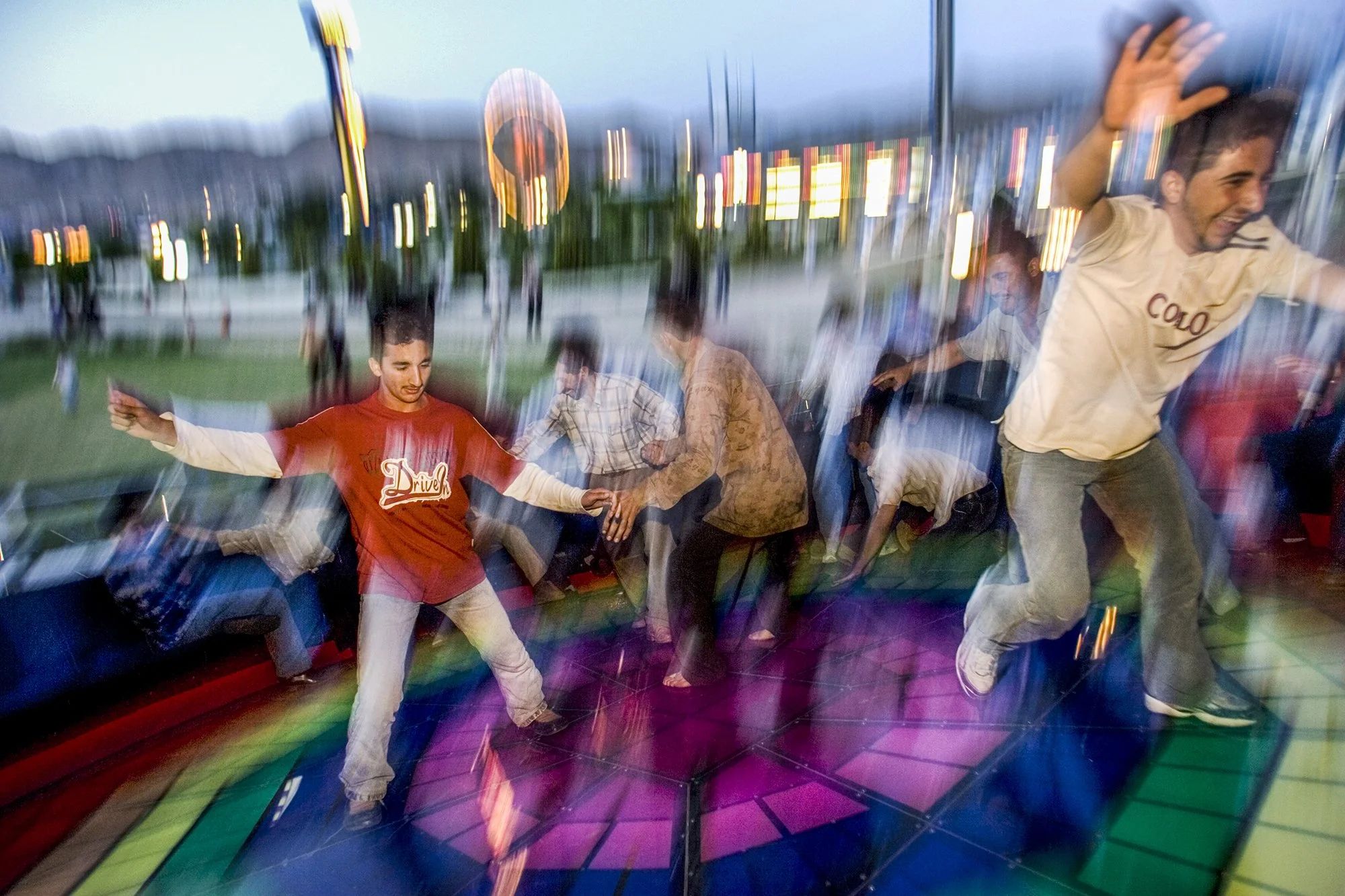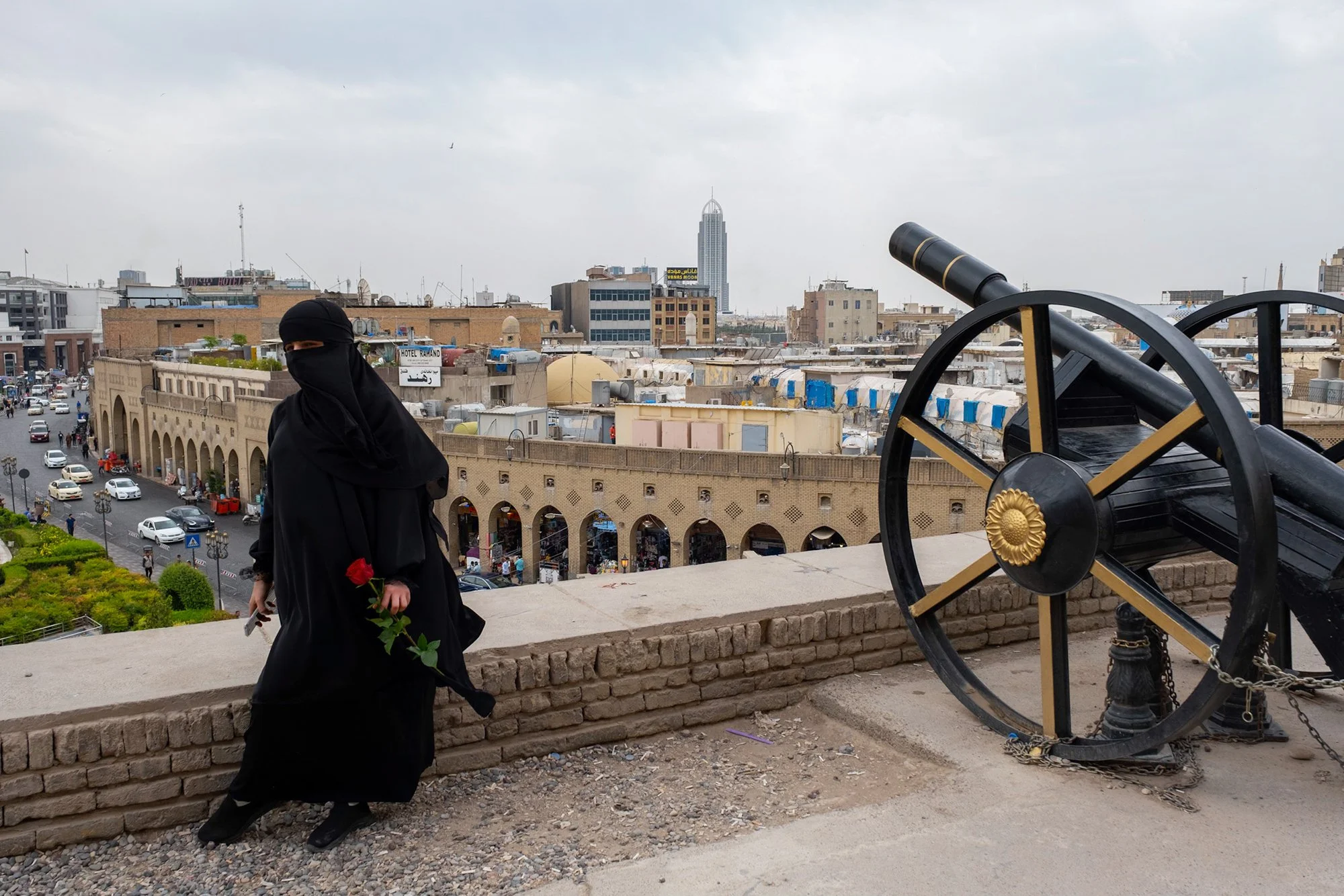

Having fled their war-torn home near Kirkuk, Iraq, a Kurdish family battles the elements in the ruins of Penjwin, Iraq, 1991.

Living under the pressure of the gun in a remote village of Turkish Kurdistan, a family waits for Turkish commandos to finish a sweep for PKK guerillas. Turkey, 1991.

Sabry Ahmed cradles her son in the ruins of Qala Diza, Iraq, 1991. The Iraqi army destroyed this city of over 100,000 residents in the 1980's but after the Gulf War in 1991, its Kurdish residents were able to return and start to rebuild their lives and homes.

The Iraqi government has imposed a strict blockade of food and fuel to the region known as Free Kurdistan, where families struggle to rebuild amid the wreckage. Iraq,1991.

Kurdish refugees near Zakho, Iraq. 1991.

Villagers cross the Lower Zaab river in Dohuk, Iraq using a rickety metal cage on a hand-pulley system, 2005. Three people a year die making this treacherous crossing.

A Kurdish refugee arrives to a camp to receive water in Zakho, Iraq on July 14, 1991. This United States run camp was home to 4,000 Kurdish refugees following the Gulf War.

The Yemesli refugee camp in Iraq was set up for displaced Iraqi Kurds after the Gulf War of 1991.

A Kurdish family buries their baby, who had just died from malnutrition, at the Ishikveren refugee camp in Turkey, 1991.

This Kurdish family in Diyarbakir, Turkey, lost two of its children to confrontations with the Turkish army. Their son and daughter both belonged to the Kurdistan Workers Party, or PKK, a militant organization that seeks to establish a Kurdish state in south-west Turkey, 1991.

A young boy looks to the camera while a mysterious, robed figure walks by in the Ali Pashi district of Diyarbakir, Turkey on Nov. 11, 1991

Kurdish woman stands trial for being accused of being a member of the Kurdistan Workers Party, or PKK, in Diyarbakir, Turkey on Sept. 16, 1991.

Kurdistan Workers Party, PKK, guerillas train in the Bekaa Valley of Lebanon on May 16, 1991.

Kurdish men receive training in Chalacholan, Iraq on July 8, 1991. These men are new recruits for the Pesh Merga, or "those who face death".

Portrait of a Kurdish Pesh Merga fighter in northern Iraq after the Gulf War in 1991.

A Kurdish girl and an American GI are mutually pleased to see each other in northern Iraq, 1991. Without the Allied presence, Kurdish autonomy and perhaps this youngest girl's life would be crushed by Saddam Hussein's vengeance.

100 Kurds from all over Iraqi Kurdistan, protest outside the U.N. headquarters in Dohuk, Iraq 1991. They felt that the U.N. was not protecting them from Sadam Hussein's forces.

The Kurdish New Year, called Newroz, is celebrated by more than 10,000 Kurds in Diyarbakir, Turkey 2003.

Young men have fun on a ride at Dream City, an amusement park in Dohuk City, Iraq on April 29, 2005.

Street scenes in Erbil, Iraq on May 7, 2023.

People on the street are reflected in mirrors in the Citadel Frame Shop, opposite Arbil's historic citadel, in Arbil, Iraq on April 17, 2005.

Scenes at the Kirkuk football stadium, where internally displaced Kurds from parts of Iraqi Kurdistan live, 2003.

A nervous Kurdish bride in Afrin, Syria, 1991. At Kurdish weddings, even the terms of divorce are pre-arranged.

Kurdish children in an early morning scene among the back alleys of the ancient city of Diyarbakir, Turkey, 1991.

Street scenes in Erbil, Iraq on May 7, 2023.

Kurdish traders at a livestock market in the town of Zahko, Iraq, 1991.

Sheep herder in Iran, 1991.

A family relaxes together during a picnic in Shaqlawa, Iraq on April 21, 2005. Every Friday, the family comes to the same mountains where Kurdish guerrillas fought the Iraqi army a generation ago.

Daily life scenes in Akre, Iraq on May 12, 2023.






























Having fled their war-torn home near Kirkuk, Iraq, a Kurdish family battles the elements in the ruins of Penjwin, Iraq, 1991.
Living under the pressure of the gun in a remote village of Turkish Kurdistan, a family waits for Turkish commandos to finish a sweep for PKK guerillas. Turkey, 1991.
Sabry Ahmed cradles her son in the ruins of Qala Diza, Iraq, 1991. The Iraqi army destroyed this city of over 100,000 residents in the 1980's but after the Gulf War in 1991, its Kurdish residents were able to return and start to rebuild their lives and homes.
The Iraqi government has imposed a strict blockade of food and fuel to the region known as Free Kurdistan, where families struggle to rebuild amid the wreckage. Iraq,1991.
Kurdish refugees near Zakho, Iraq. 1991.
Villagers cross the Lower Zaab river in Dohuk, Iraq using a rickety metal cage on a hand-pulley system, 2005. Three people a year die making this treacherous crossing.
A Kurdish refugee arrives to a camp to receive water in Zakho, Iraq on July 14, 1991. This United States run camp was home to 4,000 Kurdish refugees following the Gulf War.
The Yemesli refugee camp in Iraq was set up for displaced Iraqi Kurds after the Gulf War of 1991.
A Kurdish family buries their baby, who had just died from malnutrition, at the Ishikveren refugee camp in Turkey, 1991.
This Kurdish family in Diyarbakir, Turkey, lost two of its children to confrontations with the Turkish army. Their son and daughter both belonged to the Kurdistan Workers Party, or PKK, a militant organization that seeks to establish a Kurdish state in south-west Turkey, 1991.
A young boy looks to the camera while a mysterious, robed figure walks by in the Ali Pashi district of Diyarbakir, Turkey on Nov. 11, 1991
Kurdish woman stands trial for being accused of being a member of the Kurdistan Workers Party, or PKK, in Diyarbakir, Turkey on Sept. 16, 1991.
Kurdistan Workers Party, PKK, guerillas train in the Bekaa Valley of Lebanon on May 16, 1991.
Kurdish men receive training in Chalacholan, Iraq on July 8, 1991. These men are new recruits for the Pesh Merga, or "those who face death".
Portrait of a Kurdish Pesh Merga fighter in northern Iraq after the Gulf War in 1991.
A Kurdish girl and an American GI are mutually pleased to see each other in northern Iraq, 1991. Without the Allied presence, Kurdish autonomy and perhaps this youngest girl's life would be crushed by Saddam Hussein's vengeance.
100 Kurds from all over Iraqi Kurdistan, protest outside the U.N. headquarters in Dohuk, Iraq 1991. They felt that the U.N. was not protecting them from Sadam Hussein's forces.
The Kurdish New Year, called Newroz, is celebrated by more than 10,000 Kurds in Diyarbakir, Turkey 2003.
Young men have fun on a ride at Dream City, an amusement park in Dohuk City, Iraq on April 29, 2005.
Street scenes in Erbil, Iraq on May 7, 2023.
People on the street are reflected in mirrors in the Citadel Frame Shop, opposite Arbil's historic citadel, in Arbil, Iraq on April 17, 2005.
Scenes at the Kirkuk football stadium, where internally displaced Kurds from parts of Iraqi Kurdistan live, 2003.
A nervous Kurdish bride in Afrin, Syria, 1991. At Kurdish weddings, even the terms of divorce are pre-arranged.
Kurdish children in an early morning scene among the back alleys of the ancient city of Diyarbakir, Turkey, 1991.
Street scenes in Erbil, Iraq on May 7, 2023.
Kurdish traders at a livestock market in the town of Zahko, Iraq, 1991.
Sheep herder in Iran, 1991.
A family relaxes together during a picnic in Shaqlawa, Iraq on April 21, 2005. Every Friday, the family comes to the same mountains where Kurdish guerrillas fought the Iraqi army a generation ago.
Daily life scenes in Akre, Iraq on May 12, 2023.
